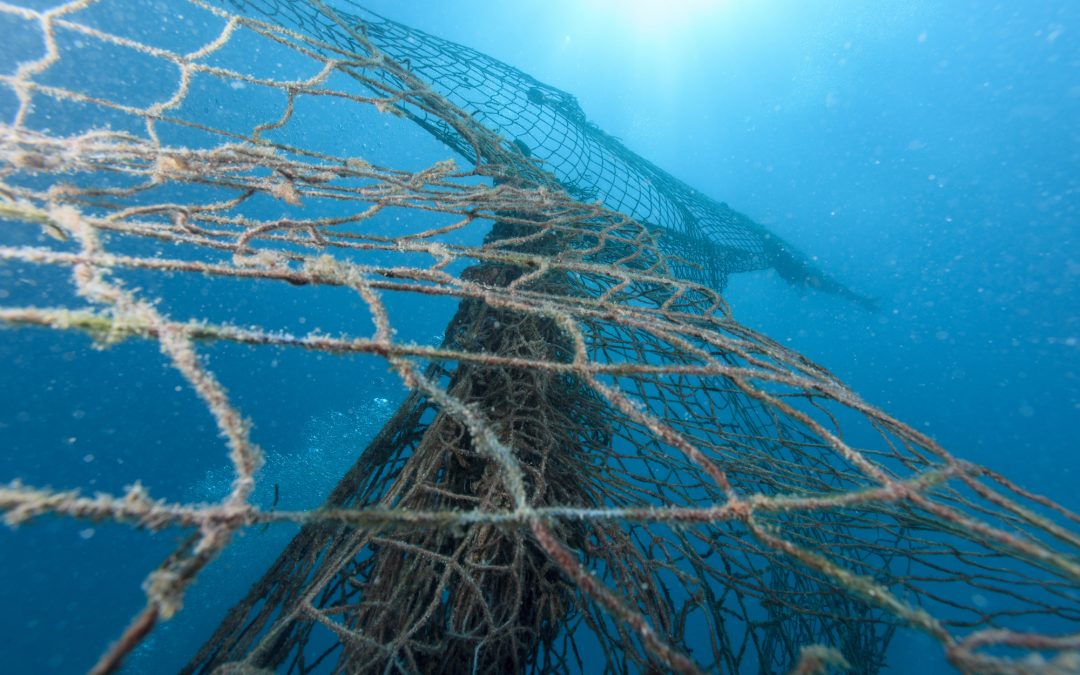For the past six months we have been working with the fishers of Muncar to pilot bycatch reduction technologies, and have had the chance to learn a lot about the local drifting gillnet fishery. One of the most surprising aspects has been the number of fishermen who lose their nets. Of the 20 fishers involved in our pilot study, at least one has reported losing their fishing gear each month. With each net having an area of approximately 500m2, these loses contribute to the serious environmental issue of ghost fishing.
Ghost fishing occurs when fishing gears such as gillnets, traps, or long-lines are lost, dumped or abandoned at sea. These unattended gears continue to capture fish as they drift the ocean currents. The United Nations reports that ghost fishing has a significant impact on target fish stocks, as well as on populations of endangered, threatened and protected species such as turtles, cetaceans, sharks and manta rays. Discarded fishing gears represent 10% of the world’s marine debris, causing damage to the seabed and tidal environments, and a hazard to navigation.

Pak Sugiyono checks his nets after a successful fishing trip
Fishers may lose their gears for many reasons. Sometimes natural conditions such as strong currents or poor weather are to blame. The Bali Strait is a narrow canal with a strong tidal flow. The middle of the strait is a deep trench that causes strong vertical currents. These conditions create complicated and unpredictable water movements. Pak Masturi, a fisher participating in our pilot study, recently lost three gillnets when returning from a fishing trip. Facing a strong current, alone in his boat and fearing for his safety, he was forced to abandon his nets.
However, in Muncar, many gillnet fishers report that conflict with other oceans users is the main reason that nets are lost.
Small-scale gillnet fishers often operate the same fishing grounds as large-scale purse seiners. Purse seines are an active fishing gear, deployed over a large area by large motorised vessels. Meanwhile, gillnets are a passive fishing gear, drifting with the currents under the supervision of a single fisher in a small boat with a single outboard engine. Even though these gears target different species, in the Bali Strait they share the same fishing grounds and seasons. With schools of sardines attracting large numbers of purse seiners, the gillnet fishers must monitor their nets carefully to ensure they are not cut by boat propellers.
The Bali Strait is a busy shipping channel. Banyuwangi’s three major ports (Ketapang, Tanjung Wangi, and Muncar) provide facilities for cargo vessels, coal barges, oil tankers, and ferries as well as fishing boats. High volumes of traffic, much of it consisting of large vessels, creates a hazard for small fishing boats and their gears.
Those problems cost the fishers time and money. Repairing a net may take four or five days, during which they will be unable to go fishing. Replacing a net costs money. Or continuing to fish with their remaining gears means a reduction in capacity and outputs. With this in mind, it is clear that ghost fishing is an issue that not only impacts the environment, but also the livelihoods and well-being of fishing communities.
It is also an issue that has considerable implications for our piloting of bycatch reduction technologies. The devices that we are using to minimise interactions between fishing nets and mobula rays must be installed onto the fishing nets. In evaluating the feasibility of these devices, we must consider the socio-economic implications, including the costs of replacing devices if they are lost at sea. As such, ghost fishing and conflicts between ocean users has serious implications for Indonesia’s sustainable fisheries.
Last year, Presidential Regulation No. 16/2017 outlined five development pillars via which Indonesia will achieve its objective of becoming a Global Maritime Fulcrum. These pillars include safety at sea; maritime governance; maritime economy, infrastructure and welfare improvement; and maritime spatial management and environmental protection.These pillars could provide the framework via which stakeholders and authorities can work together to reduce the impacts of ghost fishing on the environment and coastal communities. In the Bali Strait, for example, marine spatial planning with clearly defined shipping lanes and fishing grounds could help to minimise conflicts between resource users, and create the environment in which bycatch reduction technologies become a viable option for fishers.


